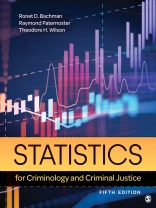Communicating the excitement and importance of criminal justice research, this practical and comprehensive book shows students how to perform and understand statistical analyses, while helping them recognize the connection between statistical analyses used in everyday life and their importance to criminology and criminal justice. This updated Fifth Edition is packed with real-world case studies and contemporary examples utilizing the most current crime data and empirical research available. Each chapter presents a particular statistical method in the context of a substantive research story.
Tabela de Conteúdo
Chapter 1. The Importance of Statistics in the Criminological Sciences or Why Do I have to Learn This Stuff?
PART I. Univariate Analysis: Describing Variable Distributions
Chapter 2. Levels of Measurement and Aggregation
Chapter 3. Understanding Data Distributions: Tabular and Graphical Techniques
Chapter 4. Measures of Central Tendency
Chapter 5. Measures of Dispersion
PART II. Making Inferences in Univariate Analysis: Generalizing From a Sample to the Population
Chapter 6. Probability, Probability Distributions, and an Introduction to Inferential Testing
Chapter 7. Point Estimation and Confidence Intervals
Chapter 8. From Estimation to Statistical Tests: Hypothesis Testing for One Population Mean and Proportion
PART III. Bivariate Analysis: Relationships Between Two Variables
Chapter 9. Testing Hypotheses With Categorical Data
Chapter 10. Hypothesis Tests Involving Two Population Means or Proportions
Chapter 11. Hypothesis Tests Involving Three or More Population Means: Analysis of Variance
Chapter 12. Bivariate Correlation and Regression
PART IV. Multivariable Analysis: Predicting One Dependent Variable with Two or More Independent Variables
Chapter 13. Controlling for a Third Variable: Multiple OLS Regression
Chapter 14. Regression Analysis With a Dichotomous Dependent Variable: Logit Models
Sobre o autor
Ronet D. Bachman, Ph D, worked as a statistician at the Bureau of Justice Statistics, U.S.Department of Justice, before going back to an academic career; she is now a professor in the Department of Sociology and Criminal Justice at the University of Delaware. She is coauthorof Statistical Methods for Criminology and Criminal Justice and coeditor of Explaining Criminalsand Crime: Essays in Contemporary Criminal Theory. In addition, she is the author of Death and Violence on the Reservation and coauthor of Stress, Culture, and Aggression; Murder American Style; and Violence: The Enduring Problem, along with numerous articles and papers that examinethe epidemiology and etiology of violence, with particular emphasis on women, the elderly, and minority populations as well as research examining desistance from crime. Her most recentfederally funded research was a mixed-methods study that examined the long-term desistancetrajectories of criminal justice involved drug-involved individuals who have been followed withboth quantitative and interview data for nearly thirty years. Her current state-funded research isassessing the needs of violent crime victims, especially those whose voices are rarely heard suchas loved ones of homicide victims.












